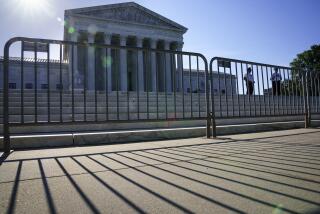Op-Ed: Make the Supreme Court bigger, but not the Democrats’ way
- Share via
For a couple decades, I have advocated for the expansion of the Supreme Court to 19 members. So you’d think I’d be delighted that Democrats, who have long opposed an expansion, suddenly seem eager to pursue it. The problem is, the Democrats are seeking change for the wrong reason and in the wrong way.
Democratic presidential candidates Sens. Kirsten Gillibrand of New York, Elizabeth Warren of Massachusetts, Kamala Harris of California, former Rep. Beto O’Rourke of Texas and South Bend, Ind., Mayor Pete Buttigieg have all embraced the idea of a larger court. They decry the five conservative votes on the current court as a partisan lock on crucial decisions, but they fail to acknowledge that there are four liberal justices who show a similar pattern of bloc voting.
These newly minted court reformers all sound a bit like Harvard constitutional law professor Lawrence Tribe, who sees the situation this way: “The time is overdue for a seriously considered plan of action by those of us who believe that McConnell Republicans, abetted by and abetting the Trump Movement, have prioritized the expansion of their own power over the safeguarding of American democracy and the protection of the most vulnerable among us.”
Democrats are seeking change for the wrong reason and in the wrong way.
That sounds like court-packing in the name of fighting court-packing. Former Atty. Gen. Eric H. Holder Jr. was more honest about what’s afoot. He declared outright that if the Democrats win the White House and the Senate in 2020, they must add two justices, just enough to achieve a new liberal majority.
The Democrats are returning to President Franklin D. Roosevelt’s failed scheme. At least Roosevelt pretended to base his plan on the age of the justices (he wanted to add a new justice for every sitting justice over 70). In 1937 Roosevelt was saddled with four conservative justices — known as the “Four Horsemen” — who opposed his New Deal. Three other justices, the “Three Musketeers,” were predictably liberal and voted together. However, the Four Horsemen and the somewhat less predictable Justice Owen Roberts carried the day most of the time. FDR got a bill introduced to allow him to appoint up to six additional justices. It died when Roberts voted to support a critical New Deal case and “Horseman” Willis Van Devanter retired: The “switch in time that saved nine.”
And yet nine is one of the worst numbers we could have come up with for a Supreme Court. The Constitution does not specify the size of the court. The first Supreme Court had six members, and, when it convened in 1790 at the Royal Exchange Building in New York, only two of those justices showed up. As of 1869, the court happened to have nine members because there were nine circuits, or federal court districts. And it has stayed that way ever since.
Our Supreme Court is the smallest of any major nation, and the result is that for periods of time we have a court of one, especially on hard cases — a single “swing vote” decides which way a 5-to-4 decision will tilt. It used to be that Justice Sandra Day O’Connor was the decider, then Justice Anthony M. Kennedy. Now it may be Chief Justice John G. Roberts Jr. Expanding the court my way would end that concentration of power. The court might split, but the deciding vote probably wouldn’t be the same justice again and again.
Enter the Fray: First takes on the news of the minute »
My proposal also avoids giving any president an advantage in nominating new justices. The increase in size would happen slowly: No president would be allowed to appoint more than two additional justices in a term. When the court was fully staffed at 19, natural turnover would start to regulate its makeup, with no one president likely to be able to push it in one direction or another, and yet with most presidents getting a chance to nominate newcomers to the court.
So why 19? Because that is roughly the size of our federal appellate courts, and such courts function well when sitting together, or en banc. I would add a rule that, each year, two of the high court justices would be dispatched to sit on lower courts, so they don’t lose touch with judging in the litigation brawl that precedes a case that rises to the Supreme Court. That would leave an active court of 17 justices. (If Congress did not want to circulate judges in the lower courts, it would expand the high court to 17 members, still big enough to spread the power and presidential prerogatives around.)
Democrats, with their call for court packing, do not have a lock on bad ideas for the high court. Rep. Mark Green (R-Tenn.) announced on Twitter that he would attempt to cement the court’s nine-justice tradition through a constitutional amendment. That would take an arbitrary number arrived at without rational debate and cement it into our Constitution for perpetuity. We would still be left with an undersized court and long periods with a court of one.
A famous quote from a Vietnam War battlefield — “It became necessary to destroy the town to save it” — applies to partisan schemes to change or set in stone the current size of the Supreme Court. Before we destroy the court to save it, we should decide on who or what is the real enemy of justice and democracy. The court is demonstrably too small, but it must be unpacked, not packed.
Jonathan Turley is a constitutional law professor at George Washington University.
Follow the Opinion section on Twitter @latimesopinionand Facebook
More to Read
A cure for the common opinion
Get thought-provoking perspectives with our weekly newsletter.
You may occasionally receive promotional content from the Los Angeles Times.










